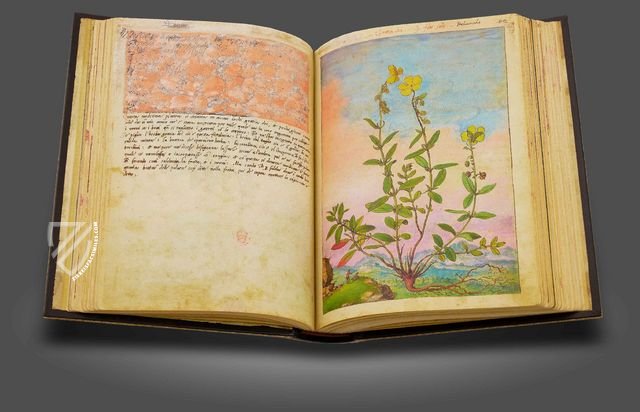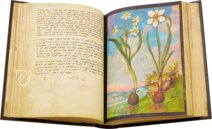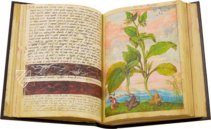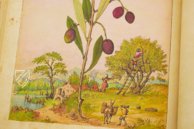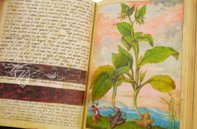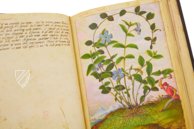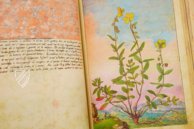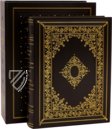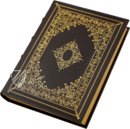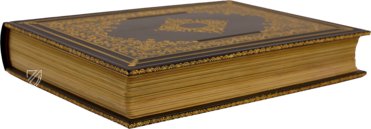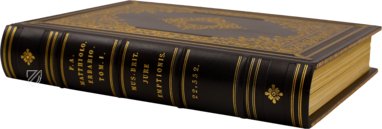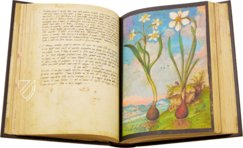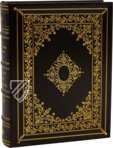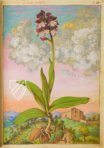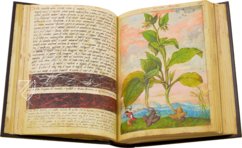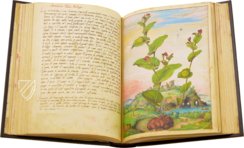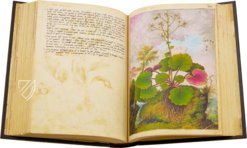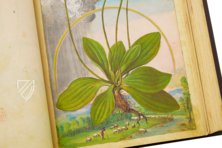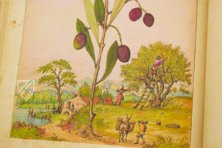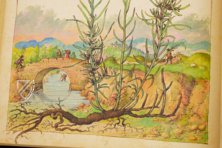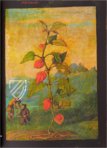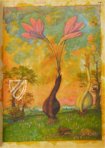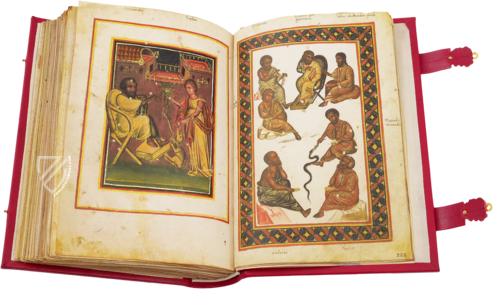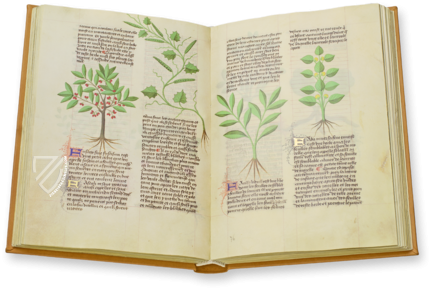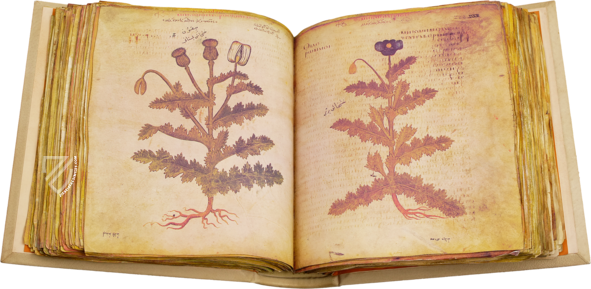Extracts from Dioscorides
(3,000€ - 7,000€)
This gorgeous botanical and medical manuscript is a true masterpiece of Renaissance book art. The virtuoso artist and botanist Gherardo Cibo (1512-1600) created the work between 1564 and 1584 for an unknown patron. It contains the so-called Discorsi, an Italian translation of the ancient magnum opus by the physician and naturalist Dioscorides, De materia medica. The creator of the Discorsi was the famous physician Pietro Andrea Mattioli (1501-1577) from Siena, who also added his own observations and findings to the ancient text. Cibo illustrated this cornerstone of modern pharmacology with more than 160 remarkable watercolours of plants and their habitats, which are among the most beautiful and naturalistic depictions of nature of the Renaissance. An important contribution to the development of modern botany and early modern landscape painting.
Extracts from Dioscorides
The ancient text De materia medica by Dioscorides (ca. AD 40-90) is a magnum opus of pharmacology and remained a fundamental medical reference well into the Early Modern period. This magnificent specimen is a superb Renaissance manuscript created ca. 1564-84 by the artistic genius and botanist Gherardo Cibo (1512-1600) that features an Italian translation of the work in addition to a selection of medical and botanical texts by Pietro Andrea Mattioli (1501-1577), a famous physician from Siena. 160+ full-page miniatures consisting of a detailed depiction of each plant set within in natural environment adorn the text and possess an artistry comparable to contemporary panel paintings.
Who was Dioscorides?
The so-called Dioscorides manuscripts trace their roots back to an ancient doctor. Pedanios Dioscorides Anazerebus was a doctor and naturalist who was born in Anazarba in Asia Minor in the 1st century. He was active as a physician in the Roman army under the Emperors Claudius and Nero. With his treatise concerning the medicinal effects of plants, but also animal and mineral materials, he composed the primary work of early medicine and the template and example for medieval pharmacopeias. De materia medica enjoyed great fame both in the Orient and the Occident with translations in numerous languages.
A Renaissance Masterpiece
Mattioli’s Discorsi is his Italian translation of Dioscorides’ De Materia Medica (1st century AD) with the addition of lengthy commentaries based on his personal experience and on popular and learned medicine. Mattioli’s book was extremely useful for physicians and herbalists not familiar with classical languages. Cibo illustrated the work with more than 160 remarkable pictures of plants and landscapes that rank amongst the most beautiful of the Renaissance. He was an avid reader and admirer of this book by Mattioli and copied entire passages in neat script, adding his own comments, anecdotes, legends, and – more importantly – illustrated them with delicate and lifelike botanical images. His splendid miniatures feature different species of plants standing out in the foreground against the brightly colored landscapes of their natural habitat. Cibo’s manuscript, with its dazzlingly beautiful miniatures, is an unusual and personal version of Mattioli’s printed work and a highly original artistic contribution to both nascent modern science and the history of botanical and landscape illustrations.
Codicology
- Alternative Titles
- Dioskurides von Cibo und Mattioli
Auszüge aus Dioscorides ''De re medica'' illustriert von Gherardo Cibo
Extracts from Dioscorides' 'De re medica' Illustrated by Gherardo Cibo
Dioscórides de Cibo y Mattioli
Mattioli’s Dioscorides Illustrated by Cibo - Type
- Manuscript on paper
- Size / Format
- 370 pages / 26.5 × 19.5 cm
- Origin
- Italy
- Date
- Ca. 1564–1584
- Epochs
- Style
- Language
- Script
- Italian Cursive
- Illustrations
- 131 full-page watercolor images; 25 watercolor botanical drawings
- Content
- Discorsi by Pietro Andrea Mattioli, based on the Antique Materia Medica by Dioscurides
- Artist / School
- Gherardo Cibo (1512–1600) (illuminator)
Pietro Andrea Mattioli (1501–77) (author) - Previous Owners
- Marchese Giovanni Battista Costabili Containi
Marchese Giovanni Costabili Containi
Extracts from Dioscorides
Rabbit Foraging for Food
Many of the plants found in this manuscript are depicted enlarged in front of naturalistic landscapes reflecting the environment in which they might be found. This miniature of Pulmonaria, commonly known as lungwort, shows a brown rabbit foraging for food among the colorful flowers in the foreground. In the background, a boat full of people is ferried across the river where more figures wait for them. A monastery surrounded by trees is depicted on the opposite bank.

Extracts from Dioscorides
Halicababum
Solanum is a genus of flowering plants including crops such as the potato, tomato, and eggplant as well as varieties Halicababum. It has broader leaves than other species of solanum with stalks that bend towards the earth after they become heavy with fruit, which consist of round pods resembling reddish bladders, hence the common name “bladder cherry”.
The fruit of the Physalis alkekengi is not used for cooking but can be used as a diuretic and as a cure for jaundice. Its juices are squeezed from the fruit and then dried in the shade to be kept for future use. Aside from its medicinal purposes, it is a popular ornamental plant that is found in gardens from Europe to Japan, where the lantern-like fruit is part of the traditional Bon Festival.

#1 Dioscórides de Cibo y Mattioli
Language: Spanish
(3,000€ - 7,000€)
- Treatises / Secular Books
- Apocalypses / Beatus
- Astronomy / Astrology
- Bestiaries
- Bibles / Gospels
- Chronicles / History / Law
- Geography / Maps
- Saints' Lives
- Islam / Oriental
- Judaism / Hebrew
- Single Leaf Collections
- Leonardo da Vinci
- Literature / Poetry
- Liturgical Manuscripts
- Medicine / Botany / Alchemy
- Music
- Mythology / Prophecies
- Psalters
- Other Religious Books
- Games / Hunting
- Private Devotion Books
- Other Genres
- Afghanistan
- Armenia
- Austria
- Belgium
- Belize
- Bosnia and Herzegovina
- China
- Colombia
- Costa Rica
- Croatia
- Cyprus
- Czech Republic
- Denmark
- Egypt
- El Salvador
- Ethiopia
- France
- Germany
- Greece
- Guatemala
- Honduras
- Hungary
- India
- Iran
- Iraq
- Israel
- Italy
- Japan
- Jordan
- Kazakhstan
- Kyrgyzstan
- Lebanon
- Liechtenstein
- Luxembourg
- Mexico
- Morocco
- Netherlands
- Palestine
- Panama
- Peru
- Poland
- Portugal
- Romania
- Russia
- Serbia
- Spain
- Sri Lanka
- Sweden
- Switzerland
- Syria
- Tajikistan
- Turkey
- Turkmenistan
- Ukraine
- United Kingdom
- United States
- Uzbekistan
- Vatican City
- A. Oosthoek, van Holkema & Warendorf
- Aboca Museum
- Ajuntament de Valencia
- Akademie Verlag
- Akademische Druck- u. Verlagsanstalt (ADEVA)
- Aldo Ausilio Editore - Bottega d’Erasmo
- Alecto Historical Editions
- Alkuin Verlag
- Almqvist & Wiksell
- Amilcare Pizzi
- Andreas & Andreas Verlagsbuchhandlung
- Archa 90
- Archiv Verlag
- Archivi Edizioni
- Arnold Verlag
- ARS
- Ars Magna
- ArtCodex
- AyN Ediciones
- Azimuth Editions
- Badenia Verlag
- Bärenreiter-Verlag
- Belser Verlag
- Belser Verlag / WK Wertkontor
- Benziger Verlag
- Bernardinum Wydawnictwo
- BiblioGemma
- Biblioteca Apostolica Vaticana (Vaticanstadt, Vaticanstadt)
- Bibliotheca Palatina Faksimile Verlag
- Bibliotheca Rara
- Boydell & Brewer
- Bramante Edizioni
- Bredius Genootschap
- Brepols Publishers
- British Library
- C. Weckesser
- Caixa Catalunya
- Canesi
- CAPSA, Ars Scriptoria
- Caratzas Brothers, Publishers
- Carus Verlag
- Casamassima Libri
- Centrum Cartographie Verlag GmbH
- Chavane Verlag
- Christian Brandstätter Verlag
- Circulo Cientifico
- Club Bibliófilo Versol
- Club du Livre
- CM Editores
- Collegium Graphicum
- Collezione Apocrifa Da Vinci
- Comissão Nacional para as Comemorações dos Descobrimentos Portugueses
- Coron Verlag
- Corvina
- CTHS
- D. S. Brewer
- Damon
- De Agostini/UTET
- De Nederlandsche Boekhandel
- De Schutter
- Deuschle & Stemmle
- Deutscher Verlag für Kunstwissenschaft
- DIAMM
- Droz
- E. Schreiber Graphische Kunstanstalten
- Ediciones Boreal
- Ediciones Grial
- Ediclube
- Edições Inapa
- Edilan
- Editalia
- Edition Deuschle
- Edition Georg Popp
- Edition Leipzig
- Edition Libri Illustri
- Editiones Reales Sitios S. L.
- Éditions de l'Oiseau Lyre
- Editions Medicina Rara
- Editorial Casariego
- Editorial Mintzoa
- Editrice Antenore
- Editrice Velar
- Edizioni Edison
- Egeria, S.L.
- Eikon Editores
- Electa
- Emery Walker Limited
- Enciclopèdia Catalana
- Eos-Verlag
- Ephesus Publishing
- Ernst Battenberg
- Eugrammia Press
- Extraordinary Editions
- Fackelverlag
- Facsimila Art & Edition
- Facsimile Editions Ltd.
- Facsimilia Art & Edition Ebert KG
- Faksimile Verlag
- Feuermann Verlag
- Folger Shakespeare Library
- Franco Cosimo Panini Editore
- Friedrich Wittig Verlag
- Fundación Hullera Vasco-Leonesa
- G. Braziller
- Gabriele Mazzotta Editore
- Gebr. Mann Verlag
- Gesellschaft für graphische Industrie
- Getty Research Institute
- Giovanni Domenico de Rossi
- Giunti Editore
- Graffiti
- Grafica European Center of Fine Arts
- Guido Pressler
- Guillermo Blazquez
- Gustav Kiepenheuer
- H. N. Abrams
- Harrassowitz
- Harvard University Press
- Helikon
- Hendrickson Publishers
- Henning Oppermann
- Herder Verlag
- Hes & De Graaf Publishers
- Hoepli
- Holbein-Verlag
- Houghton Library
- Hugo Schmidt Verlag
- Idion Verlag
- Il Bulino, edizioni d'arte
- ILte
- Imago
- Insel Verlag
- Insel-Verlag Anton Kippenberger
- Instituto de Estudios Altoaragoneses
- Instituto Nacional de Antropología e Historia
- Istituto dell'Enciclopedia Italiana - Treccani
- Istituto Ellenico di Studi Bizantini e Postbizantini
- Istituto Geografico De Agostini
- Istituto Poligrafico e Zecca dello Stato
- Italarte Art Establishments
- Jan Thorbecke Verlag
- Johnson Reprint Corporation
- Josef Stocker
- Josef Stocker-Schmid
- Jugoslavija
- Karl W. Hiersemann
- Kasper Straube
- Kaydeda Ediciones
- Kindler Verlag / Coron Verlag
- Kodansha International Ltd.
- Konrad Kölbl Verlag
- Kurt Wolff Verlag
- La Liberia dello Stato
- La Linea Editrice
- La Meta Editore
- Lambert Schneider
- Landeskreditbank Baden-Württemberg
- Leo S. Olschki
- Les Incunables
- Liber Artis
- Library of Congress
- Libreria Musicale Italiana
- Lichtdruck
- Lito Immagine Editore
- Lumen Artis
- Lund Humphries
- M. Moleiro Editor
- Maison des Sciences de l'homme et de la société de Poitiers
- Manuscriptum
- Martinus Nijhoff
- Maruzen-Yushodo Co. Ltd.
- MASA
- Massada Publishers
- McGraw-Hill
- Metropolitan Museum of Art
- Militos
- Millennium Liber
- Müller & Schindler
- Nahar - Stavit
- Nahar and Steimatzky
- National Library of Wales
- Neri Pozza
- Nova Charta
- Oceanum Verlag
- Odeon
- Orbis Mediaevalis
- Orbis Pictus
- Österreichische Staatsdruckerei
- Oxford University Press
- Pageant Books
- Parzellers Buchverlag
- Patrimonio Ediciones
- Pattloch Verlag
- PIAF
- Pieper Verlag
- Plon-Nourrit et cie
- Poligrafiche Bolis
- Presses Universitaires de Strasbourg
- Prestel Verlag
- Princeton University Press
- Prisma Verlag
- Priuli & Verlucca, editori
- Pro Sport Verlag
- Propyläen Verlag
- Pytheas Books
- Quaternio Verlag Luzern
- Reales Sitios
- Recht-Verlag
- Reichert Verlag
- Reichsdruckerei
- Reprint Verlag
- Riehn & Reusch
- Roberto Vattori Editore
- Rosenkilde and Bagger
- Roxburghe Club
- Salerno Editrice
- Saltellus Press
- Sandoz
- Sarajevo Svjetlost
- Schöck ArtPrint Kft.
- Schulsinger Brothers
- Scolar Press
- Scrinium
- Scripta Maneant
- Scriptorium
- Shazar
- Siloé, arte y bibliofilia
- SISMEL - Edizioni del Galluzzo
- Sociedad Mexicana de Antropología
- Société des Bibliophiles & Iconophiles de Belgique
- Soncin Publishing
- Sorli Ediciones
- Stainer and Bell
- Studer
- Styria Verlag
- Sumptibus Pragopress
- Szegedi Tudomànyegyetem
- Taberna Libraria
- Tarshish Books
- Taschen
- Tempus Libri
- Testimonio Compañía Editorial
- Thames and Hudson
- The Clear Vue Publishing Partnership Limited
- The Facsimile Codex
- The Folio Society
- The Marquess of Normanby
- The Richard III and Yorkist History Trust
- Tip.Le.Co
- TouchArt
- TREC Publishing House
- TRI Publishing Co.
- Trident Editore
- Typis Regiae Officinae Polygraphicae
- Union Verlag Berlin
- Universidad de Granada
- University of California Press
- University of Chicago Press
- Urs Graf
- Vallecchi
- Van Wijnen
- VCH, Acta Humaniora
- VDI Verlag
- VEB Deutscher Verlag für Musik
- Verlag Anton Pustet / Andreas Verlag
- Verlag Bibliophile Drucke Josef Stocker
- Verlag der Münchner Drucke
- Verlag für Regionalgeschichte
- Verlag Styria
- Vicent Garcia Editores
- W. Turnowski Ltd.
- W. Turnowsky
- Waanders Printers
- Wiener Mechitharisten-Congregation (Wien, Österreich)
- Wissenschaftliche Buchgesellschaft
- Wissenschaftliche Verlagsgesellschaft
- Wydawnictwo Dolnoslaskie
- Xuntanza Editorial
- Zakład Narodowy
- Zollikofer AG

